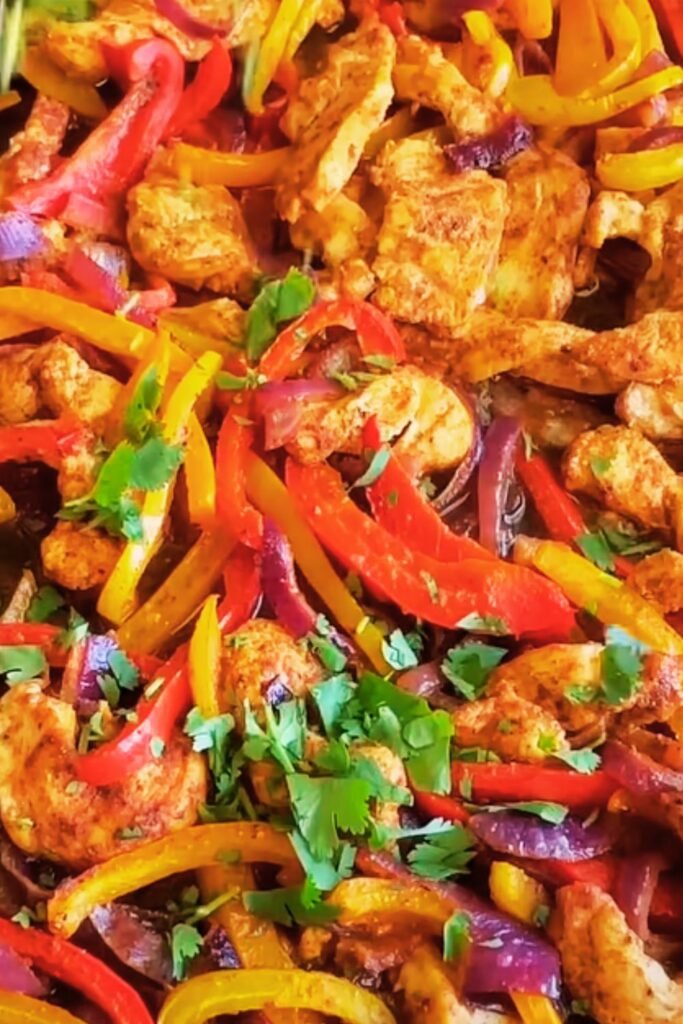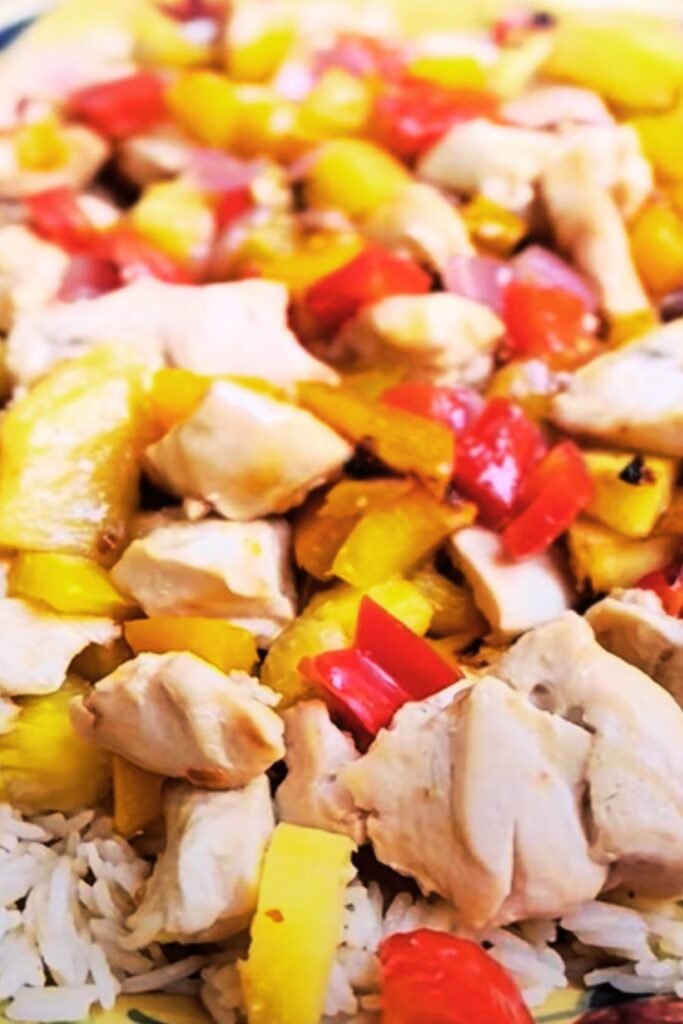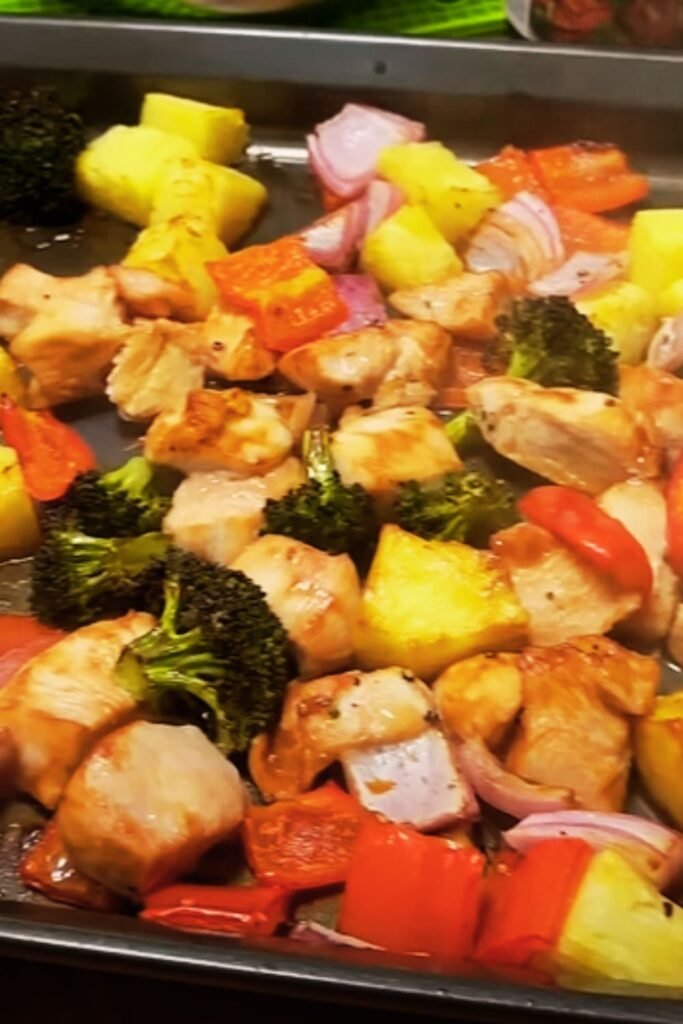There’s something magical about the combination of sweet pineapple, savory chicken, and colorful vegetables that instantly transports me to a Hawaiian beach. I’ve been perfecting this Hawaiian Chicken Sheet Pan recipe for years, and it never fails to bring sunshine to my dinner table – even on the gloomiest winter evenings.
What makes this dish absolutely irresistible is how it captures all the beloved flavors of Hawaiian cuisine while requiring minimal cleanup. I remember the first time I made this recipe for my family; the kitchen filled with the most incredible aroma of caramelized pineapple and perfectly seasoned chicken. My kids, who are notoriously picky eaters, devoured every single piece and asked for seconds.
This one-pan wonder has become my go-to solution for busy weeknights when I want something both delicious and nutritious without spending hours in the kitchen. The best part? Everything cooks together, allowing the flavors to meld beautifully while you handle other tasks.
Understanding Hawaiian Chicken Sheet Pan
Hawaiian Chicken Sheet Pan: A complete meal featuring seasoned chicken pieces, fresh pineapple chunks, and colorful vegetables, all roasted together on a single sheet pan with Hawaiian-inspired flavors including teriyaki, ginger, and garlic.
Sheet Pan Cooking: A cooking method where all ingredients are arranged on a large, rimmed baking sheet and roasted in the oven simultaneously, creating a complete meal with minimal preparation and cleanup.
Teriyaki Glaze: A sweet and savory Japanese-inspired sauce made from soy sauce, sugar, ginger, and garlic that caramelizes beautifully when roasted, creating a glossy, flavorful coating.
The Magic Behind This Recipe
What sets my Hawaiian Chicken Sheet Pan apart from other recipes is the careful balance of flavors and textures. I’ve discovered that the secret lies in the marinade timing and the strategic placement of ingredients on the pan.
The chicken needs just enough time to absorb the teriyaki flavors without becoming overly salty. I typically marinate mine for 2-4 hours, which provides the perfect flavor penetration. The pineapple adds natural sweetness that caramelizes during cooking, creating those beautiful golden edges that make this dish so visually appealing.
Essential Ingredients Breakdown
| Ingredient | Quantity | Purpose | Substitution Options |
|---|---|---|---|
| Chicken Thighs | 2 lbs (bone-in, skin-on) | Main protein, stays juicy | Chicken breasts, drumsticks |
| Fresh Pineapple | 2 cups chunks | Natural sweetness, tropical flavor | Canned pineapple (drained) |
| Bell Peppers | 3 medium (mixed colors) | Color, crunch, nutrients | Any color combination |
| Red Onion | 1 large | Mild sweetness when roasted | Yellow onion, sweet onion |
| Soy Sauce | 1/3 cup | Umami base for marinade | Tamari, coconut aminos |
| Brown Sugar | 1/4 cup | Balances saltiness, aids caramelization | Honey, maple syrup |
| Fresh Ginger | 2 tbsp minced | Aromatic warmth | Ground ginger (1 tsp) |
| Garlic | 4 cloves minced | Flavor foundation | Garlic powder (1 tsp) |
| Rice Vinegar | 2 tbsp | Acidity balance | Apple cider vinegar |
| Sesame Oil | 1 tbsp | Nutty depth | Olive oil |
| Green Onions | 4 stalks | Fresh finish | Chives, cilantro |
Step-by-Step Cooking Process
Preparation Phase
I always start by preheating my oven to 425°F (220°C). This high temperature is crucial for achieving that perfect caramelization on both the chicken skin and pineapple pieces.
For the Marinade:
- Whisk together soy sauce, brown sugar, minced ginger, garlic, rice vinegar, and sesame oil in a large bowl
- Add chicken pieces and coat thoroughly
- Let marinate for 2-4 hours in the refrigerator (minimum 30 minutes if you’re short on time)

Vegetable Preparation
While the chicken marinates, I prepare my vegetables. The key is cutting everything into similar-sized pieces to ensure even cooking:
- Bell peppers: Cut into 1-inch strips
- Red onion: Slice into thick wedges (about 1/2 inch)
- Pineapple: Cut into 1-inch chunks (if using fresh)
Assembly and Cooking
Step 1: Arrange the Chicken Remove chicken from marinade (reserve the liquid!) and place pieces skin-side up on one half of a large rimmed baking sheet. I always use parchment paper for easier cleanup.
Step 2: Add Vegetables Toss the prepared vegetables with 2 tablespoons of the reserved marinade and arrange them around the chicken, leaving space for even air circulation.
Step 3: Initial Roasting Roast for 25 minutes without opening the oven door. This initial cooking time allows the chicken skin to start crisping.
Step 4: Add Pineapple Remove the pan and add pineapple chunks to the empty spaces. The pineapple goes in later because it cooks faster and can become mushy if overcooked.
Step 5: Final Cooking Return to oven for 15-20 more minutes, or until chicken reaches an internal temperature of 165°F (74°C).
Step 6: Glaze and Rest Brush remaining marinade over everything and let rest for 5 minutes before serving.
Timing and Temperature Guide
| Cooking Stage | Temperature | Duration | Visual Cues |
|---|---|---|---|
| Initial Roast | 425°F (220°C) | 25 minutes | Skin begins browning |
| With Pineapple | 425°F (220°C) | 15-20 minutes | Golden caramelization |
| Resting Period | Room temperature | 5 minutes | Juices redistribute |
| Total Time | – | 45-50 minutes | Internal temp 165°F |
Nutritional Benefits
This Hawaiian Chicken Sheet Pan isn’t just delicious – it’s incredibly nutritious too. I love how this single dish provides a complete nutritional profile:
Protein Powerhouse: Chicken thighs offer high-quality protein while remaining more flavorful and juicy than breasts. Each serving provides approximately 35-40 grams of protein.
Vitamin C Boost: The combination of bell peppers and pineapple delivers more than 100% of your daily vitamin C needs, supporting immune function and collagen production.
Antioxidant Rich: Pineapple contains bromelain, an enzyme that aids digestion, while bell peppers provide beta-carotene and other antioxidants.

Serving Suggestions and Pairings
I’ve served this dish countless times, and here are my favorite accompaniments:
Grain Options:
- Jasmine rice (my personal favorite – the fragrance complements the Hawaiian flavors beautifully)
- Brown rice for added fiber
- Quinoa for a protein boost
- Cauliflower rice for low-carb option
Fresh Additions:
- Steamed broccoli or snap peas
- Simple green salad with sesame dressing
- Roasted sweet potatoes
- Grilled asparagus
Sauce Enhancements:
- Extra teriyaki glaze on the side
- Sriracha for heat lovers
- Fresh lime wedges for brightness
- Toasted sesame seeds for crunch
Storage and Meal Prep Tips
This recipe is fantastic for meal preparation. I often double the recipe on Sundays and portion it out for the week:
Refrigerator Storage: Properly stored, this dish keeps for 3-4 days in airtight containers. I separate the chicken and vegetables into different containers to maintain optimal texture when reheating.
Freezer Storage: While best enjoyed fresh, you can freeze portions for up to 2 months. I recommend slightly undercooking if you plan to freeze, as reheating will continue the cooking process.
Reheating Instructions: Reheat in a 350°F oven for 10-12 minutes, or use the microwave in 30-second intervals until heated through. Avoid overcooking during reheating to maintain texture.
Troubleshooting Common Issues
| Problem | Cause | Solution | Prevention |
|---|---|---|---|
| Dry Chicken | Overcooked or lean cuts | Use meat thermometer | Choose thighs over breasts |
| Soggy Vegetables | Overcrowding or excess moisture | Use larger pan, pat dry | Single layer arrangement |
| Burnt Pineapple | Added too early | Add in final 15-20 minutes | Follow timing precisely |
| Bland Flavor | Insufficient marinating | Marinate longer next time | Minimum 30 minutes marinating |
| Uneven Cooking | Inconsistent piece sizes | Cut uniformly | Use ruler if needed |
Recipe Variations I Love
Over the years, I’ve experimented with numerous variations of this basic recipe:
Spicy Hawaiian: Add 1-2 jalapeños and a dash of red pepper flakes to the marinade for those who enjoy heat.
Mediterranean Twist: Replace pineapple with cherry tomatoes and add olives and feta cheese in the final 5 minutes.
Asian Fusion: Include snap peas, mushrooms, and water chestnuts for added crunch and Asian flavors.
Low-Sodium Version: Use low-sodium soy sauce and increase the ginger and garlic for flavor compensation.

Expert Tips for Perfect Results
Through trial and error, I’ve learned several crucial tips that make the difference between good and extraordinary results:
Skin-Side Up Always: Never flip the chicken during cooking. Keeping the skin side up ensures maximum crispiness while the meat stays juicy.
Don’t Overcrowd: Use a large sheet pan (18×13 inches minimum) and arrange ingredients in a single layer. Overcrowding creates steam, preventing proper caramelization.
Reserve Marinade Wisely: Always save some marinade before adding raw chicken for basting and extra flavor. Never use marinade that has touched raw chicken without boiling it first.
Temperature Matters: Use an instant-read thermometer for accuracy. Chicken should reach exactly 165°F in the thickest part.
The Science Behind the Flavors
Understanding the science helps me achieve consistent results every time. The Maillard reaction – the browning that occurs when proteins and sugars are heated – is responsible for the complex, caramelized flavors in this dish.
The high roasting temperature (425°F) is essential for achieving this reaction while keeping cooking time reasonable. Lower temperatures would require longer cooking times and wouldn’t produce the same depth of flavor.
The sugar in the marinade not only adds sweetness but also promotes browning. This is why I always use brown sugar rather than white – the molasses content adds complexity while enhancing caramelization.
Frequently Asked Questions
Q: Can I use boneless chicken for this recipe? Yes, but you’ll need to reduce the cooking time to about 25-30 minutes total. Boneless pieces cook faster and can dry out easily, so I recommend using a meat thermometer.
Q: What if I can’t find fresh pineapple? Canned pineapple works perfectly! Just make sure to drain it thoroughly and use chunks rather than rings. Fresh gives slightly better texture, but canned is more convenient and still delicious.
Q: Can I prepare this ahead of time? Absolutely! You can marinate the chicken and prep the vegetables up to 24 hours in advance. Store everything separately in the refrigerator and assemble just before cooking.
Q: Is this recipe gluten-free? The recipe as written contains soy sauce, which typically contains gluten. Use tamari or coconut aminos as a gluten-free substitute.
Q: What’s the best way to cut pineapple? Remove the crown and base, stand the pineapple upright, and cut away the skin in strips from top to bottom. Remove any remaining “eyes” with a paring knife, then cut into chunks. Don’t discard the core – it’s perfectly edible and adds fiber!
Q: Can I double this recipe? Yes, but you’ll need two sheet pans to avoid overcrowding. Rotate the pans halfway through cooking to ensure even browning.
Q: How do I know when the chicken is perfectly done? The internal temperature should reach 165°F, the skin should be golden brown and crispy, and the juices should run clear when pierced with a knife.
Q: What vegetables work best in this dish? Bell peppers, onions, and pineapple are classics, but zucchini, mushrooms, cherry tomatoes, and snap peas all work wonderfully. Choose vegetables with similar cooking times.
Q: Can I make this dairy-free? This recipe is naturally dairy-free! Just ensure your soy sauce or substitute doesn’t contain any dairy additives.
Q: How can I make this healthier? Remove the chicken skin before eating to reduce calories and fat, serve over cauliflower rice instead of regular rice, and add extra vegetables to increase the nutritional density.
This Hawaiian Chicken Sheet Pan has become more than just a recipe in my kitchen – it’s a reliable weeknight hero that consistently delivers both flavor and convenience. The combination of sweet, savory, and slightly tangy flavors creates a meal that satisfies every palate while requiring minimal effort and cleanup.
I hope you’ll give this recipe a try and experience the same joy it brings to my family’s dinner table. There’s something truly special about a meal that can transport you to tropical paradise while keeping you grounded in the comfort of your own kitchen.